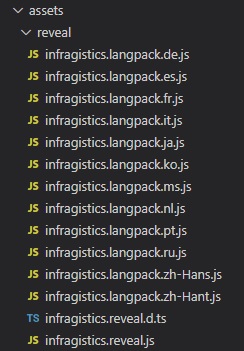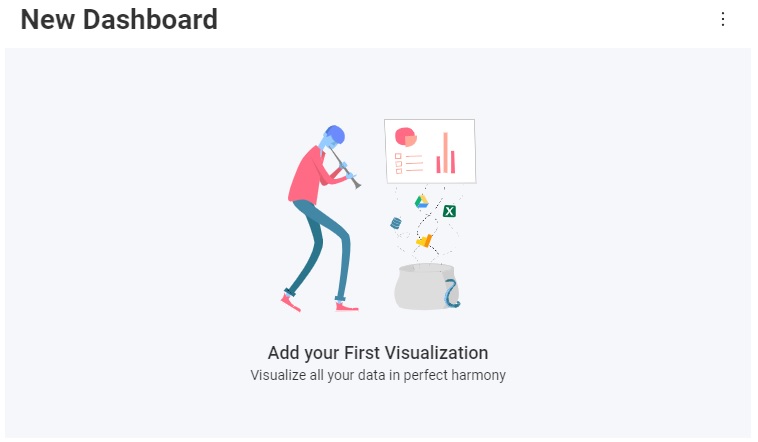Getting Started with Analytics SDK for HTML/JavaScript
Step 1 - Create an HTML File
1 - Open your favorite code editor and create a new HTML file and save the file with the name index.html
<!DOCTYPE html>
<html lang="en">
<head>
<meta charset="UTF-8">
<meta http-equiv="X-UA-Compatible" content="IE=edge">
<meta name="viewport" content="width=device-width, initial-scale=1.0">
<title>Analytics Sdk - HTML/JavaScript</title>
</head>
<body>
</body>
</html>
Step 2 - Add Analytics JavaScript API
1 - Create a new folder called assets and then create another folder called reveal within the assets folder.

2 - Copy all the JavaScript files located at %public%/Documents/Infragistics/Analytics/SDK/Web/JS/Client into the assets/reveal folder you created previously.

3 - Modify the index.html file to include the infragistics.reveal.js script at the bottom of the page just before the closing </body> tag.
<script src="./assets/reveal/infragistics.reveal.js"></script>
4 - Install the remaining Analytics JavaScript API dependencies:
- Jquery 2.2 or greater
<script src="https://cdn.jsdelivr.net/npm/jquery@3.6.0/dist/jquery.min.js"></script>
- Day.js 1.8.15 or greater
<script src="https://unpkg.com/dayjs@1.8.21/dayjs.min.js"></script>
- Quill RTE 1.3.6 or greater
<link href="https://cdn.quilljs.com/1.3.6/quill.snow.css" rel="stylesheet" type="text/css">
<script src="https://cdn.quilljs.com/1.3.6/quill.min.js"></script>
- Spectrum v 1.8.0 or newer (Optional) - this is only needed if you enable the UI for the end user to set the background color for a particular visualization.
<link href="https://cdnjs.cloudflare.com/ajax/libs/spectrum/1.8.0/spectrum.min.css" rel="stylesheet" type="text/css" >
<script src="https://cdnjs.cloudflare.com/ajax/libs/spectrum/1.8.0/spectrum.min.js"></script>
The final index.html files should look similar to this:
<!DOCTYPE html>
<html lang="en">
<head>
<meta charset="UTF-8">
<meta http-equiv="X-UA-Compatible" content="IE=edge">
<meta name="viewport" content="width=device-width, initial-scale=1.0">
<title>Analytics Sdk - HTML/JavaScript</title>
<link href="https://cdn.quilljs.com/1.3.6/quill.snow.css" rel="stylesheet" type="text/css">
</head>
<body>
<script src="https://cdn.jsdelivr.net/npm/jquery@3.6.0/dist/jquery.min.js"></script>
<script src="https://cdn.quilljs.com/1.3.6/quill.min.js"></script>
<script src="https://unpkg.com/dayjs@1.8.21/dayjs.min.js"></script>
<script src="./assets/reveal/infragistics.reveal.js"></script>
</body>
</html>
Step 3 - Initialize the Analytics view
1 - Modify the index.html file and add a new <div> tag after the opening <body> tag, and set the id to revealView.
<div id="revealView" style="height: 920px; width: 100%;"></div>
2 - Add a JavaScript Script tag at the bottom of the index.html file and initialize the revealView.
<script type="text/javascript">
$.ig.AnalyticsSdkSettings.ensureFontsLoadedAsync().then(() => {
var revealView = new $.ig.AnalyticsView("#revealView");
});
</script>
}
This JavaScript code first calls the $.ig.AnalyticsSdkSettings.ensureFontsLoadedAsync to ensure that all fonts have been properly loaded. Next, we instantiate a new instance of the AnalyticsView by creating a new $.ig.AnalyticsView and passing in the #revealView selector.
The final index.html file should look like this:
<!DOCTYPE html>
<html lang="en">
<head>
<meta charset="UTF-8">
<meta http-equiv="X-UA-Compatible" content="IE=edge">
<meta name="viewport" content="width=device-width, initial-scale=1.0">
<title>Analytics Sdk - HTML/JavaScript</title>
<link href="https://cdn.quilljs.com/1.3.6/quill.snow.css" rel="stylesheet" type="text/css">
</head>
<body>
<div id="revealView" style="height: 920px; width: 100%;"></div>
<script src="https://cdn.jsdelivr.net/npm/jquery@3.6.0/dist/jquery.min.js"></script>
<script src="https://cdn.quilljs.com/1.3.6/quill.min.js"></script>
<script src="https://unpkg.com/dayjs@1.8.21/dayjs.min.js"></script>
<script src="./assets/reveal/infragistics.reveal.js"></script>
<script type="text/javascript">
$.ig.AnalyticsSdkSettings.ensureFontsLoadedAsync().then(() => {
var revealView = new $.ig.AnalyticsView("#revealView");
});
</script>
</body>
</html>
Important
Clients apps must set the $.ig.AnalyticsSdkSettings.setBaseUrl("url-to-server"); to the server address hosting the dashboards if the client is being hosting on a different URL.
Step 4 - Run the Application
Double-click on the index.html file to launch the webpage in your default browser.

Congratulations! You have written your first Analytics SDK application.
Next Steps:
Note
The source code to this sample can be found on GitHub.
